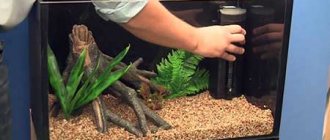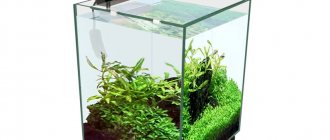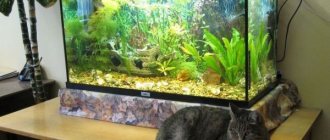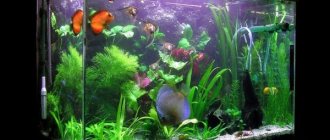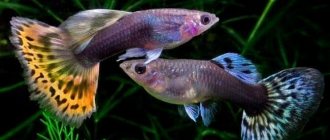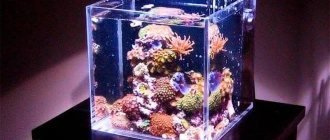How many fish can you
For an aquarium of 20 liters, we give the fish and their number.
Guppy
Quantity - 8 pieces.
Guppy is a small fish 1–4 cm in size, belonging to the viviparous species. It lives in fresh or brackish waters of the Amazon, Brazil, and Barbados. The species has clearly developed sexual dimorphism, which is expressed in the color and size of males and females.
Cockerels
Quantity - 6 pieces.
Bettas are fish from the genus Labyrinthidae, distinguished by their bright colors and veil-like fins. Another name, betta fish, was obtained due to the aggressive and pugnacious behavior of the males. It is not recommended to share with other fish due to possible aggression.
Cardinals
Quantity - 4 pieces.
Cardinals are fish from the Cyprinidae family. The species was discovered in China and lived in streams and small rivers, but was completely exterminated in the wild. They reach a length of 4 cm, the body color is brown with a green tint.
Neons
Quantity - 8 pieces.
Neons are fish from the Characin family, native to the tropics. They live in South America. Neons can be accommodated for their miniature size and eye-catching coloring.
Danio rerio
Quantity - 4 pieces.
Danio rerio is a fish from the Cyprinidae family that lives in fresh waters. It grows up to 4 cm, the body is silvery with bright horizontal stripes. It was the Danio rerio that was first genetically modified with bioluminescence genes.
Norman's Blue-Eyed
Quantity - 4 pieces.
The Norman blue-eye is a fish from the Poeciliaceae family that lives in the waters of western Africa. These are suitable fish for a 20 liter aquarium due to their small size and noticeable blue color.
Shell cichlids
Quantity - 2 pieces.
Shell cichlids are a species of the genus Cichlidae, native to the Tanganyika River. It got its name because of its amazing ability to hide in the empty shells of snails and other mollusks. It has an aggressive and arrogant character; it is advisable to keep the fish separately from other species.
Filters and heaters
Water heaters are required in cases where the room temperature drops below +21°C or if fish accustomed to a tropical climate live in an artificial reservoir.
Disadvantages of cheap heaters. For a small tank you will need a high-quality heater with good thermoregulation performance. Cheap devices do not regulate temperature well, which in a small artificial reservoir can lead to the death of aquarium inhabitants and green spaces in case of overheating.
Selection of filter devices . When choosing a filter, problems may arise, since most types of such equipment are not suitable for nano-aquariums. Due to their great power, they create too intense a current, which carries away fish and harms plant crops. An airlift filter, which you can make yourself or purchase in specialized stores, will help solve the problem.
The average filter capacity for a 20 liter aquarium should be about 60-80 liters per hour.
The ideal option for nano-aquariums is hanging external filters that do not take up much space in an already small artificial reservoir.
Other inhabitants
Freshwater shrimp
Quantity - 30–50 pieces.
Shrimp are crustacean creatures from the order Decapods. The size of representatives ranges from 2 to 25 cm. Suitable species: cherry shrimp, Japanese pond shrimp, crystal shrimp, yellow shrimp.
Snails
Quantity - 15 pieces.
Snails are gastropods with an external shell. Suitable species: apple snails, sand melania, niritids, Chinese snails.
frogs
Quantity - 10 pieces.
Frogs are tailless amphibians, the maximum size is 25 cm. The aquariums contain the Hymenochirus frog and the clawed frog.
Priming
With the help of soil, a balanced biosphere of the environment is created. This happens because bacteria and microorganisms that are beneficial to fish multiply between the soil particles. You will also need soil in such an aquarium for planting vegetation. It is better to use commercial soil that is safe for fish, rather than natural soil. If there is no other choice, then carefully treat the natural soil.
After selecting the soil, spread it evenly on the bottom and fill it with a small stream of water, avoiding erosion. For a 20-liter aquarium, the layer of soil is 4 cm. This amount is enough for planting small plants, and the soil does not take up extra space.
For a tank of this volume, soil with small particle sizes is suitable. Choose large ones only if you want to create a certain image. Coarse sand or highly crushed pebbles work well.
Soil selection
Soil plays an important role in maintaining optimal parameters of the aquatic environment in tanks of different sizes. Soil of suitable volume and fraction promotes the formation of beneficial bacteria that process the waste products of the inhabitants of the aquatic world. For a 20-liter aquarium (also called a nano-aquarium), the best option is nutritious soil, which can be purchased in specialized stores.
The benefits of soil . Compositions such as Dennerle, ADA, etc. improve water quality, activate the growth of beneficial microflora, create optimal conditions for the growth of green spaces, especially before introducing fish into the aquarium for the first time. The only drawback of such soil can be considered its rather high cost. An alternative is fine soil, such as crushed pebbles, quartz, sand, basalt or granite chips.
Laying and quantity.
It is important that the soil covers the bottom of the artificial reservoir by approximately 30 cm.
For a 20 liter aquarium you will need from 3 to 5 kg of soil (depending on the specific type of soil).
Vegetation
In small aquariums, plants play an important role, not just decorative. Plants ensure the exchange of carbon dioxide and oxygen, which is important for the life of fish. Living plants are planted in small tanks, because it is not always possible to install a powerful compressor or aerator. Plants with small leaves and thin stems are suitable for a 20-liter aquarium. The root system should also not be too developed, otherwise the amount of soil will not be enough for growth.
Arrangement of the aquarium
Having decided to purchase a twenty-liter aquarium, you first need to decide on the shape of the tank. Small artificial reservoirs are available in different models: there are cubes, round containers, aquariums in the form of glasses, flasks and rectangular vessels. Experienced aquarists recommend choosing a standard rectangular model, since the fish will be calmer in it than in unusual tanks. In addition, caring for an aquarium in the shape of a rectangle is easier and more convenient.
Water
For a small tank, it is important to keep the water clean. Due to its volume, the water quickly becomes polluted and poisons the inhabitants. To maintain cleanliness, purchase an additional container in which the replacement water will settle. If the option of settling the water is not suitable, then pet stores sell special products that, when added, make the water suitable for fish.
In a small tank, water evaporates quickly, so add water if necessary. Monitor the water level daily.
Equipment
The care and maintenance of a compact 20 liter aquarium is difficult to maintain without special equipment.
Lighting
Daylight alone is not enough for fish, so additional lighting is built into the aquarium lid, attached to the walls, or hanging lamps are used. Using lighting devices, daylight hours are created. Inhabitants are harmed by both short daylight hours and constant light.
To illuminate small aquariums, choose energy-saving lamps or fluorescent lamps.
The danger of lighting a 20-liter aquarium is the possible overheating of the water and rapid temperature changes. To prevent this, monitor the thermometer and adjust the height and timing of the light source.
Compressor
Compressors are devices designed for aeration and saturation of water with oxygen in aquariums. For a small aquarium, it is important to choose the correct hose length. If you select the wrong hose, too short or too long, the compressor will not work at full capacity. Compressors designed for large containers are also not suitable. This threatens oxygen oversaturation, which is harmful for fish, and noise.
Decor
When designing a 20-liter aquarium, consider the small size of the tank. Extra decorations and dense plants take away the space necessary for fish to live. Therefore, choose small decorative items, place them on the sides, and not in the central part. Suitable for decoration:
- Small stones.
- Snags, tree branches.
- Not overgrowing plants or mosses.
Take a look at this post on Instagram
Addition, expansion ranchu.goldfish (@ranchu.goldfish) Sich 27, 2019 about 2:51 PST
Live aquarium plants
Plants are what will bring life to any home aquarium, even if there are no fish or shrimp in it. Plants will help stabilize the environment, normalize water levels, and create more surface area for bacterial growth.
A 20 liter aquarium is a very small space, but the choice of live aquatic plants for it is huge. You should immediately exclude large plants, and be careful when choosing fast-growing plants.
Small saprophytic plants : anubias, ferns, bucephalandra - an excellent choice for a small volume. They often don't need much light and grow slowly. The following plants are suitable: Thai fern, Vendel's fern, narrow-leaved, fork-leaved; Anubias nano, nano gold; Bucephalandra of almost all species.
| Plant species |
| Aquatic mosses - all types. |
| Ground cover : Hemianthus cube, Hydrocotyla tripartita, Ranunculus inundatus, Glossostigma, Marsilia and many others. |
| Small cryptocorynes: Cryptocoryne parva, brilliant. |
| Small long-stemmed and rosette plants : staurogyne, blixa, ammania bonsai, pogostemon helfera, guayana pinnate, sintyag, shady micrantemum, rotala ratundifolia, didiplis diandra and others. |
| Bucephalandra |

